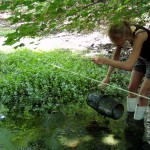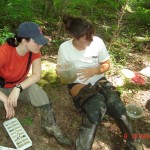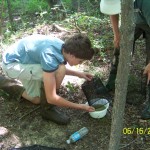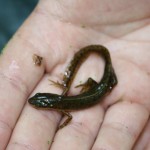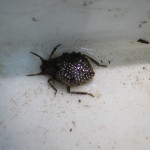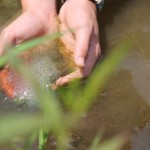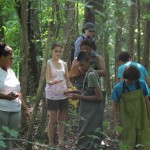About
Ephemeral pools only contain water for a portion of the year, usually, but not always drying up by late summer. Because water may not be present throughout the year, a ephemeral pool is devoid of organisms that require permanent aquatic habitats, like fish. This make ephemeral pools ideal sites for amphibians laying eggs, as fish often consume amphibian eggs and larvae.
Project Overview
For this study, students examine wetland areas to determine if they are ephemeral, or temporary pools. ephemeral pools are devoid of organisms that require permanent aquatic habitats (fish). We looked for amphibians, aquatic insects and aquatic plants at each location and collected data on what we found.
Inquiry Questions
Do the wetlands at CCR include ephemeral pools?
Data Collection
Students visit aquatic pools and use an established protocol from the Massachusetts Audubon Society (1993) to determine whether the aquatic pool was indeed a ephemeral pool. We identify obligate and facultative species of amphibians, as well as aquatic insects and aquatic plants found in the wetland. All amphibians are collected, identified, measured, weighed, categorized by age class and returned to the wetland.
Students also conduct the following activities.
- Locate the wetland on an aerial orthographic map
- Prepare a diagram with particular attention to accurate marking of water inlets and outlets (if present)
- Take water temperature and atmospheric data in different areas
Additionally, students capture Eastern Newts in minnow traps and dip nets. We analyze the newts, recording sex and general age classification data, as well as length and weight.
Data Sheets
Over the years, we have run three different types of projects.
The first was a survey/certification project. We use the following data sheet for this project.
Download Data Sheets:
Vernal Pool Observation Forms (Word)
Vernal Pool Observation Forms (PDF)
The second was an individual trap study where we divided the vernal pool into quadrants and recorded species from traps located in each quadrant.
Download Data Sheets:
Vernal Pool Population Survey for Individual Traps (Word)
Vernal Pool Population Survey for Individual Traps (PDF)
Our third project was a general sampling of animals.
Download Data Sheets:
Vernal Pool Population Survey (Word)
Vernal Pool Population Survey (PDF)
Species Identified So Far
Species list coming soon!
Additional Photos

